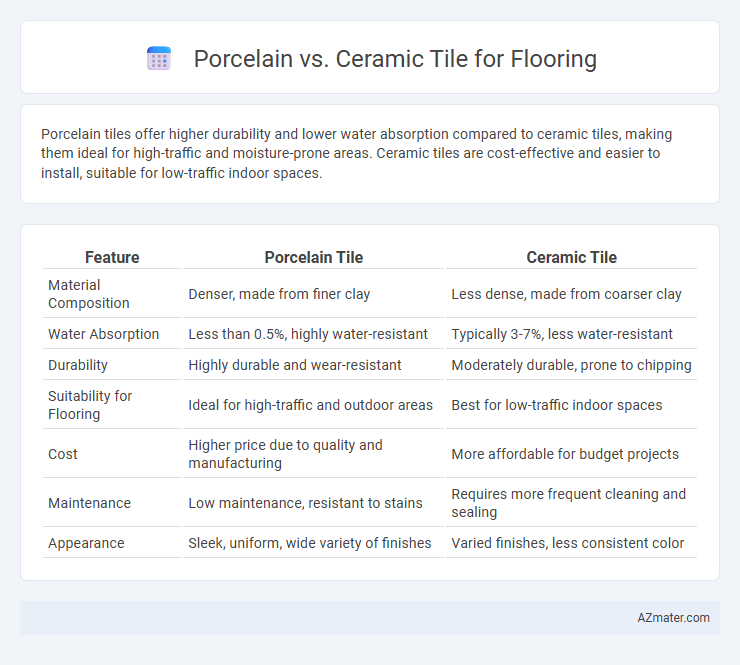Porcelain tiles offer higher durability and lower water absorption compared to ceramic tiles, making them ideal for high-traffic and moisture-prone areas. Ceramic tiles are cost-effective and easier to install, suitable for low-traffic indoor spaces.
Table of Comparison
| Feature | Porcelain Tile | Ceramic Tile |
|---|---|---|
| Material Composition | Denser, made from finer clay | Less dense, made from coarser clay |
| Water Absorption | Less than 0.5%, highly water-resistant | Typically 3-7%, less water-resistant |
| Durability | Highly durable and wear-resistant | Moderately durable, prone to chipping |
| Suitability for Flooring | Ideal for high-traffic and outdoor areas | Best for low-traffic indoor spaces |
| Cost | Higher price due to quality and manufacturing | More affordable for budget projects |
| Maintenance | Low maintenance, resistant to stains | Requires more frequent cleaning and sealing |
| Appearance | Sleek, uniform, wide variety of finishes | Varied finishes, less consistent color |
Introduction to Porcelain and Ceramic Tiles
Porcelain and ceramic tiles are popular flooring options made from natural clay but differ in composition and firing temperature, affecting durability and water absorption. Porcelain tiles are denser and fired at higher temperatures, making them more resistant to moisture, stains, and wear, ideal for high-traffic and wet areas. Ceramic tiles, while less dense, offer greater design flexibility and cost-effectiveness, suitable for residential spaces with moderate foot traffic.
Key Differences Between Porcelain and Ceramic Tiles
Porcelain tiles are denser and less porous than ceramic tiles, making them more durable and water-resistant, ideal for high-traffic or moisture-prone areas like bathrooms and kitchens. Ceramic tiles are generally softer and easier to cut, offering more design flexibility but less resistance to wear and moisture. Porcelain requires specialized cutting tools due to its hardness, while ceramic tiles are more affordable, making them suitable for budget-conscious flooring projects.
Composition and Manufacturing Processes
Porcelain tiles are made from a denser mixture of fine clay and minerals, fired at higher temperatures (typically above 1,200degC), resulting in a harder, less porous surface compared to ceramic tiles, which use a coarser clay blend with lower firing temperatures (around 1,000-1,150degC). The manufacturing process of porcelain involves vitrification, creating a glass-like, water-resistant finish ideal for high-traffic or moisture-prone areas, while ceramic tiles often feature a glaze applied post-firing to achieve color and pattern variations. These differences in composition and firing techniques directly impact the durability, water absorption rate (porcelain below 0.5%, ceramic around 3-7%), and suitability for various flooring applications.
Durability and Longevity Comparison
Porcelain tile offers superior durability and longevity compared to ceramic tile due to its denser composition and lower water absorption rate, making it highly resistant to wear, scratches, and moisture damage. Ceramic tiles are more prone to chipping and cracking under heavy foot traffic or impact, limiting their lifespan in high-traffic areas. Porcelain's enhanced strength and resistance make it ideal for both residential and commercial flooring applications requiring long-term performance.
Water and Stain Resistance
Porcelain tiles offer superior water resistance due to their dense, non-porous composition, making them ideal for moisture-prone areas such as bathrooms and kitchens. Ceramic tiles, while also water-resistant, have a higher porosity which can absorb more moisture, potentially leading to staining and damage over time. Both materials resist stains, but porcelain's low water absorption rate enhances its durability against spills and harsh cleaning agents.
Design, Color, and Texture Options
Porcelain tiles offer a wider range of design, color, and texture options compared to ceramic tiles due to their denser composition and advanced manufacturing techniques. Porcelain can mimic natural stone, wood, and concrete with high-resolution printing technology, providing more realistic and diverse patterns. Ceramic tiles generally have a glossier finish and fewer color variations, making them suitable for simpler design settings.
Installation Requirements and Techniques
Porcelain tile requires a more precise substrate preparation due to its low porosity and higher density, often necessitating a flat and stable surface to prevent cracking. Ceramic tile installation is more forgiving with substrate imperfections and typically involves using standard mortar and grout, making it suitable for DIY projects. Both types benefit from professional installation to ensure proper alignment, cutting, and spacing for durability and aesthetic appeal.
Maintenance and Cleaning Needs
Porcelain tiles offer superior durability and resistance to stains and moisture, making them easier to maintain compared to ceramic tiles that are more porous and prone to absorbing liquids. Regular sweeping and mopping with pH-neutral cleaners keep porcelain floors looking pristine, while ceramic tiles may require more frequent sealing to prevent staining and damage. Both tile types benefit from prompt spill cleanup, but porcelain's dense composition minimizes deep dirt infiltration, reducing long-term cleaning efforts.
Cost Analysis and Budget Considerations
Porcelain tiles typically cost more than ceramic tiles due to their denser composition and higher durability, with prices ranging from $3 to $10 per square foot compared to $1 to $5 for ceramic. Installation costs for porcelain can also be higher because of its hardness, requiring specialized tools and skilled labor, impacting overall budget planning. Budget considerations should weigh the long-term benefits of porcelain's wear resistance against the initial savings offered by ceramic tiles, especially in high-traffic areas.
Best Applications: Which Tile is Right for Your Floor?
Porcelain tile boasts superior durability and low porosity, making it ideal for high-traffic areas, bathrooms, and kitchens where moisture resistance is crucial. Ceramic tile offers a more affordable option with a wide variety of designs, best suited for low-traffic spaces like bedrooms and living rooms. Choosing the right tile depends on factors like foot traffic, exposure to water, and budget constraints to ensure longevity and aesthetic fit.

Infographic: Porcelain vs Ceramic Tile for Flooring
 azmater.com
azmater.com